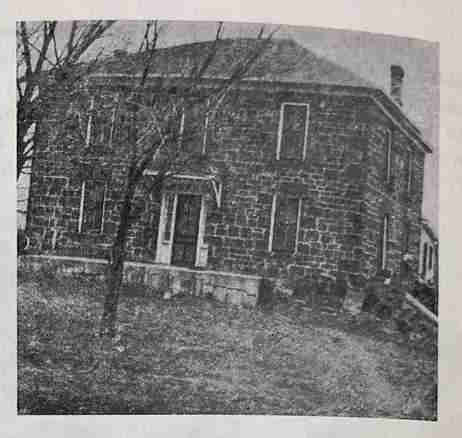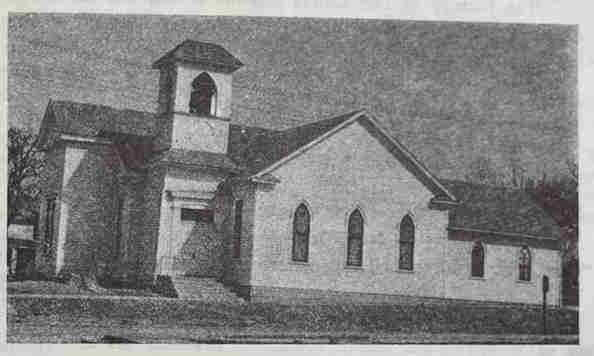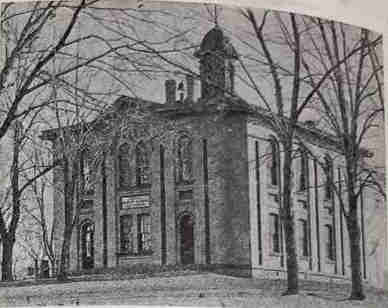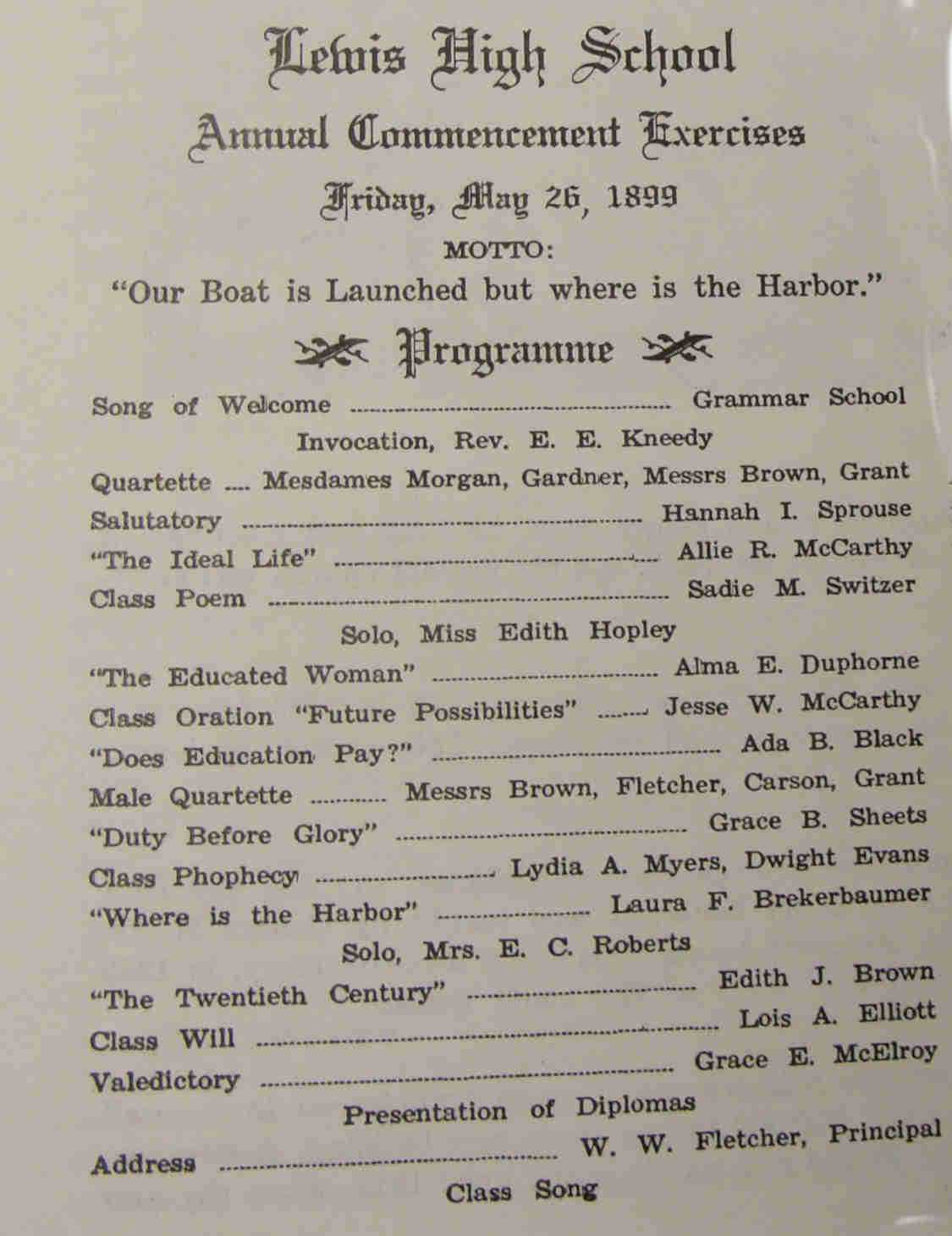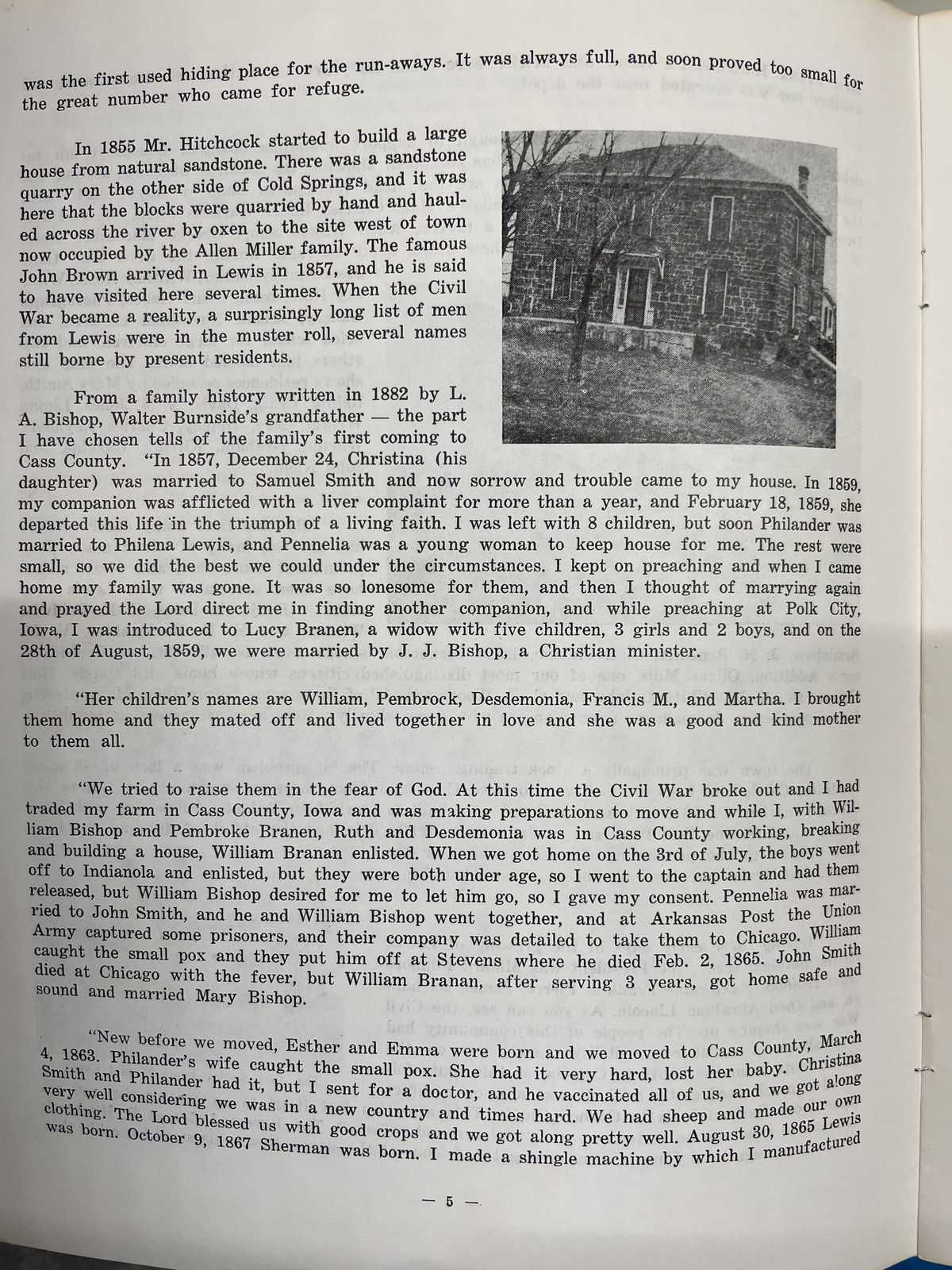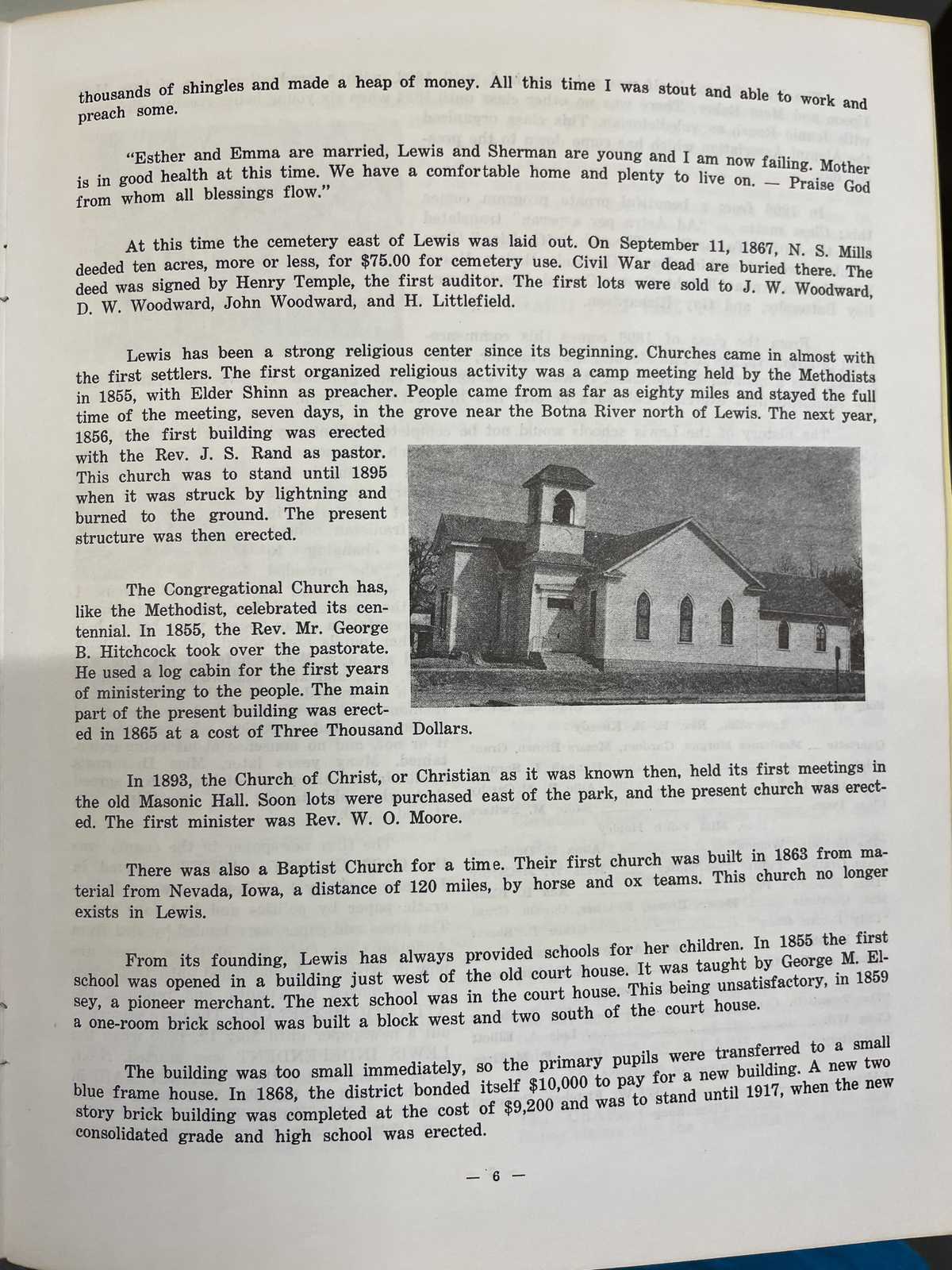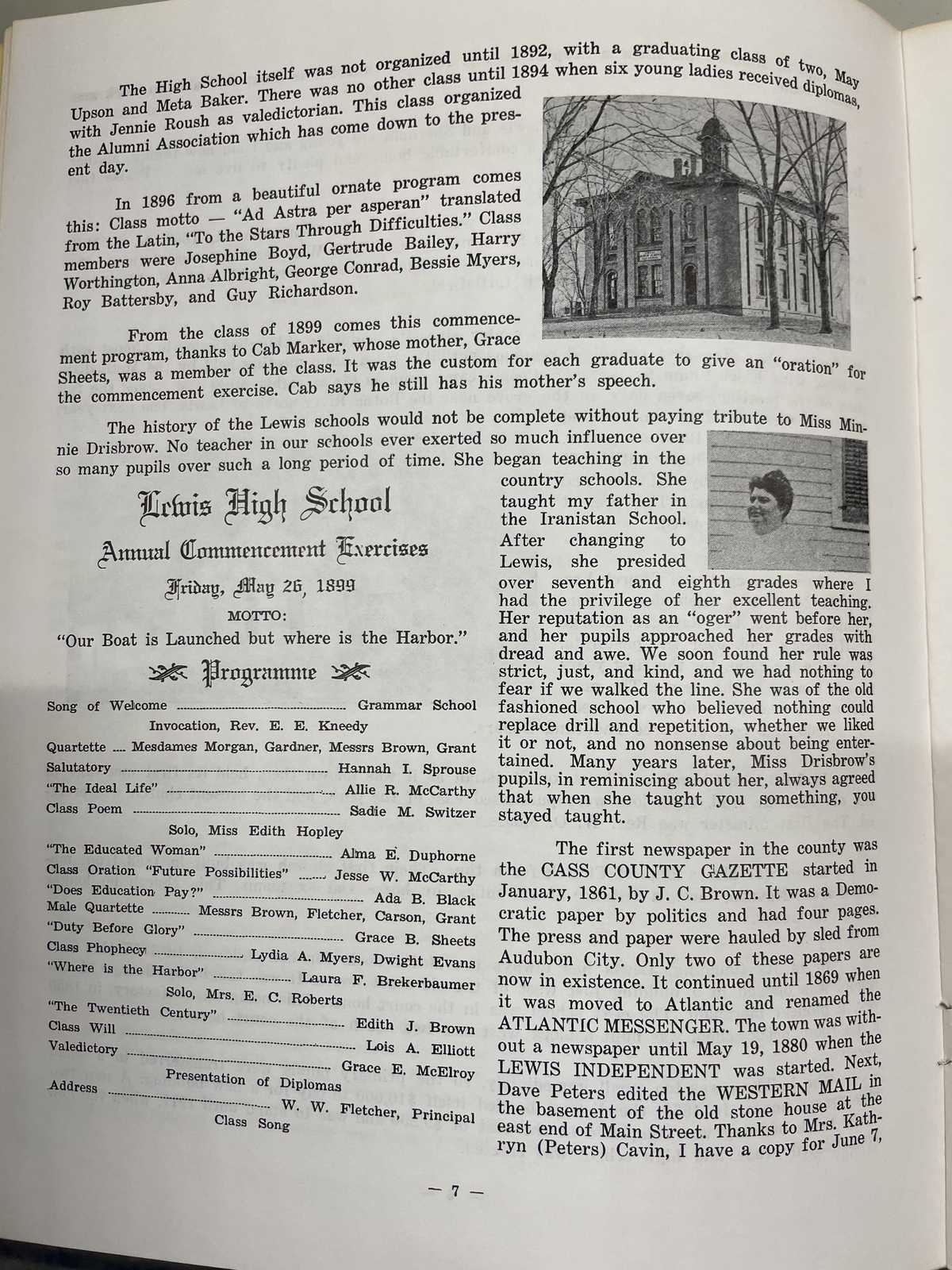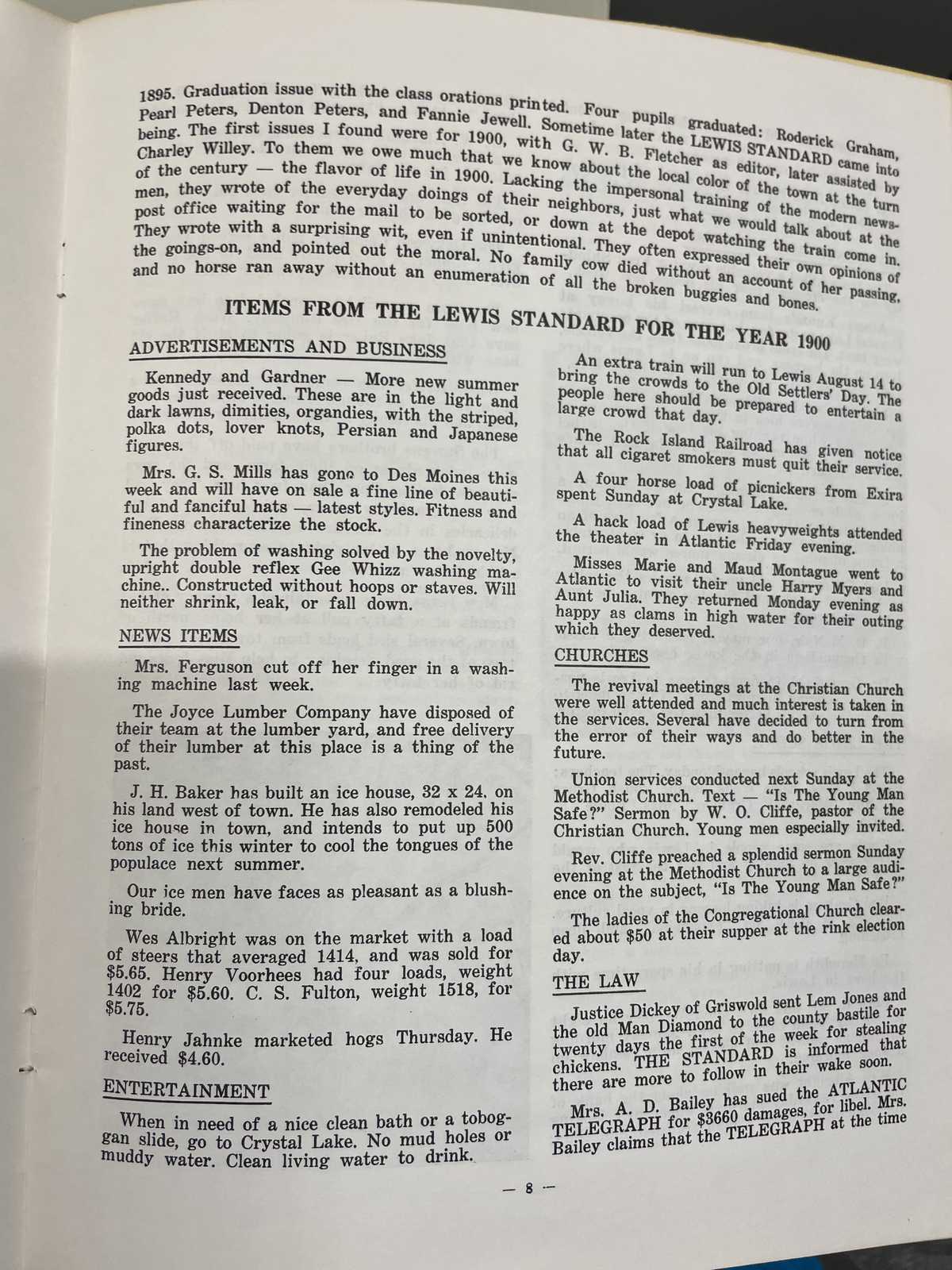HISTORICAL LEWIS (Cont'd)
|
was the first used hiding place for the run-aways. It was always full, and soon proved too small for the great number who came for refuge. In 1855 Mr. Hitchcock started to build a large house from natural sandstone. There was a sandstone quarry on the other side of Cold Springs, and it was here that the blocks were quarried by hand and hauled across the river by oxen to the site west of town now occupied by the Allen Miller family. The famous John Brown arrivedin Lewis in 1857, and he is said to have visited here several times. When the Civil Was became a reality, a surprisingly long list of men from Lewis were in the muster roll, several names still borne by present residents. From a family history written in 1882 by L. A. Bishop, Walter Burside's grandfather -- the part I have chosen tells of the family's first coming to Cass County. "In 1857, December 24, Christina (his daughter) was married to Samuel Smith and now sorrow and trouble came to my house. In 1859, my companion was afflicted with a liver complaint for more than a year, and February 18, 1859, she departed this life in the triumph of a living faith. I was left with 8 children, but soon Philander was married to Philena Lewis, and Pennelia was a young woman to keep house for me. The rest were small, so we did the best we could under the circumstances. I kept on preaching and when I came home my family was gone. It was so lonesome for them, and then I thought of marrying again and prayed the Lord direct me in finding another companion, and while preaching at Polk City, Iowa, I was introduced to Lucy Granen, a widow with five children, 3 girls and 2 boys, and on the 28th of August, 1859, we were married by J. J. Bishop, a Christian minister. "Her children's names are William, Pembrock, Desdemonia, Francis M., and Martha. I brought them home and they mated off and lived together in love and she was a good and kind mother to them all. "We tried to raise them in the fear of God. At this time the Civil War broke out and I had traded my farm in Cass County, Iowa and was making preparations to move and while I, with William Bishop and Pembroke Branen, Ruth and Desdemonia was in Cass County working, breaking and building a house, William Branan enlisted. When we got home on the 3rd of July, the boys went off to Indianola and enlisted, but they were both under age, so I went to the captain and had them released, but William Bishop desired for me to let him go, so I gave my consent. Pennelia was married to John Smith, and he and WIlliam Bishop went together, and at Arkansas Post the Union Army captured some preisoners, and their company was detailed to take them to Chicago. William caught the small pox and they put him off at Stevens where he died Feb. 2, 1865. John Smith died at Chicago with the fever, but William Branan, after serving 3 years, got home safe and sound and married Mary Bishop. "New before we moved, Esther and Emma were born and we moved to Cass County, March 4, 1863. Philander's wife caught the small pox. She had it very hard, lost her baby. Christina Smith and Philander had it, but I sent for a doctor, and he vaccinated all of us, and we got along very well considering we was in a new country and times hard. We had sheep and made our own clothing. The Lord bessed us with good crops and we got along pretty well. August 39, 1865 Lewis was born. October 9, 1867 Sherman was born. I made a shingle machine by which I manufacture
- 5 -
thousands of shingles and made a heap of money. All this time I was stout and able to work and preach some."Esther and Emma are married, Lewis and Sherman are young and I am now failing. Mother is in good health at this time. We have a comfortable home and plenty to live on. -- Praise God from whom all blessings flow." At this time the cemetery east of Lewis was laid out. On September 11, 1867, N. S. Mills deeded ten acres, more or less, for $75.00 for cemetery use. Civil War dead are buried there. The deed was signed by Henry Temple, the first auditor. The first lots were sold to J. W. Woodward, D. W. Woodward, John Woodward, and H. Littlefield. Lewis has been a strong religious center since its beginning. Churches came in almost with the first settlers. The first organized religious activity was a camp meeting held by the Methodists in 1855, with Elder Shinn as preacher. People came from as far as eighty miles and stayed the full time of the meeting, seven days, in the grove near the Botna River north of Lewis. The nextyear, in 1856, the first building was erected with the Rev. J. S. Rand as pastor. This church was to stand until 1895 when it was struck by lightning and burned to the ground. The present structure was then erected. The Congregartional Church has, like the Methodist, celebrated its centennial. In 1855, the Rev. Mr. George R. Hitchcock took over the pastorate. He used a log cabin for the first years of ministering to the people. The main part of the present building was erected in 1865 at a cost of Three Thousand Dollars. In 1893, the Church of Christ, or Christian as it was known then, held its first meetings in the old Masonic Hall. Soon lots were purchased east of the park, and the present church was erected. The first minister was Rev. W. O. Moore. There was also a Baptist Church for a time. Their first church was built in 1863 from material from nevade, Iowa, a distance of 120 miles, by horse and ox teams. This church no longer exists in Lewis. From its founding, Lewis has always provided schools for her children. In 1855 the first school was opened in a building just west of the old court house. It was taught by George M. Elsey, a pioneer merchant. The next school was in the court house. This being unsatisfactory, in 1859 a one-room brick school was built a block west and two south of the court house. The building was too small immediately, so the primary pupils were transferred to a small blue frame house. In 1868, the district bonded itself $10,000 to pay for a new building. A new two story brick building was completed at the cost of $9,200 and was to stand until 1917, when the new consolidated grade and high school was erected.
- 6 -
The High School itself was not organized until 1892, with a graduating class of two, May Upson and Meta Baker. There was no other class until 1894 when six young ladies received diplomas, with Jennie Roush as valedictorian. This class organized the Alumni Association which has come down to the present day.In 1896 from a beautiful ornate program comes this: Class motto -- "Ad Astra per asperan" translated from the Latin, "To the Stars Through Difficulties." Class members were Josephine Boyd, Gertrude Bailey, Harry Worthington, Anna Albright, George Conrad, Bessie Myers, Roy Battersby, and Guy Richardson. From the class of 1899 comes this commencement program, thanks to Cab Marker, whose mother, Grace Sheets, was a member of the class. It was the custom for each graduate to give an "oration" for the commencement exercist. Cab says he still has his mother's speech. The history of the Lewis schools would not be complete without paying tribute to Miss Minnie Drisbrow [?sic Disbrow?]. No teacher in our schools ever exerted so much influence over so many pupils over such a long period of time. She began teaching in the country schools. She taught my father in the Iranistan School. After changing to Lewis, she presided over seventh and eighth grades where I had the privilege of her excellent teaching. Her reputation as an "oger" [sic ogre] went before her, and her pupils approached her grades with dread and awe. We soon found her rule was strict, just, and kind, and we had nothing to fear if we walked the line. She was of the old fashioned school who believed nothing could replace drill and repetition, whether we liked it or not, and no nonsense about being entertained. Many years later, Miss Drisbrow's [?sic Disbrow's?] pupils, in reminiscing about her, always agreed that when she taught you something, you stayed taught. The first newspaper in the county was the CASS COUNTY GAZETTE started in January, 1861, by J. C. Brown. It was a Democratic paper by politics and had four pages. The press and paper were hauled by sled from Audubon City. Only two of these papers are now in existence. It continued until 1869 when it was moved to Atlantic and renamed the ATLANTIC MESSENGER. The town was without a newspaper until May 19, 1880 when the LEWIS INDEPENDENT was started. Next, Dave Peters edited the WESTERN MAIL, in the basement of the old stone house at the east end of Main Street. Thanks to Mrs. Kathryn (Peters)Cavin, I have a copy for June 7,
- 7 -
1895. Graduation issue with the class orations printed. Four pupils graduated: Roderick Graham, Pearl Peters, Denton Peters, and Fannie Jewell. Sometime later the LEWIS STANDARD came into being. The first issues I found were for 1900, with G. W. B. Fletcher as editor, later assited by Charley Willey. To them we owe much that we know about the local color of the town at the turn of the century -- the flavor of life in 1900. Lacking the impersonal training of the modern newsmen, they wrote of the everyday doings of their neighbors, just what we would talk about at the post office waiting for the mail to be sorted, or down at the depot watching the train come in. They wrote with a surprising wit, even if unintentional. They often expressed their own opinions of the goings-on, and pointed out the moral. No family cow died without an account of her passing, and no horse ran away without an enumeration of all broken buggies and bones. |
<== PREV = = = = = = = = = = NEXT ==>
Transcribed by Cheryl Siebrass, June, 2024, from Historical Lewis by Pauline Franklin, pp. 5-8.
Copyright © 1996
The IAGenWeb Project
IAGenWeb Terms, Conditions
& Disclaimer


